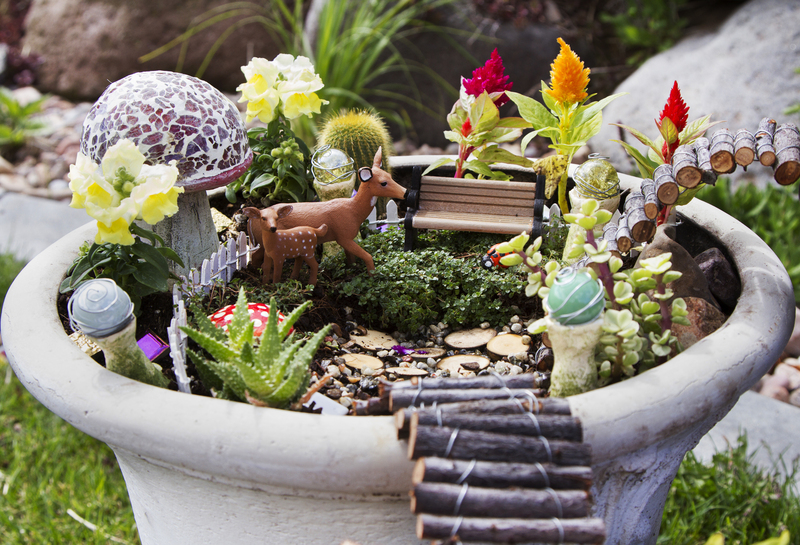Gardening Against the Wind: Innovative Solutions
Posted on 04/06/2025
Gardening Against the Wind: Innovative Solutions for Every Gardener
Gardening in a windy environment poses unique challenges, but with the right strategies, you can create a thriving, wind-resistant oasis. Whether you are a hobbyist or a seasoned horticulturist, learning how to garden successfully against the wind is essential for lush, protected outdoor spaces.

Why Wind is a Threat for Gardens
Before diving into the best wind-resistant gardening solutions, it's important to understand how wind can negatively impact your garden:
- Physical Damage: Strong winds can break stems, snap branches, and uproot young plants.
- Moisture Loss: Wind increases evaporation, drying out soil and plant foliage much more quickly.
- Reduced Growth: Persistent wind stress stunts plants, leading to poor yield and aesthetic damage.
- Pest and Disease Spread: Wind spreads spores and pests, making your plants more vulnerable.
Understanding Your Microclimate
Gardens can vary greatly depending on their location. To implement innovative wind protection solutions, start by evaluating your site:
- Observe prevailing winds: Which direction do the strongest winds come from? Use local weather data and your own observations.
- Identify natural barriers: Are there fences, walls, buildings, or robust hedgerows that already offer protection?
- Check topography: Is your garden in a valley, on a hilltop, or exposed on open plain? Elevation impacts wind exposure.
Traditional Wind Protection Methods
Initially, many gardeners try using physical barriers. Here are some tried-and-true approaches:
1. Windbreaks and Shelterbelts
- Evergreen hedges: Hedges of cotoneaster, privet, or laurel act as living screens.
- Staggered tree and shrub plantings: Rows of conifers, willows, or native shrubs filter the wind without causing turbulence.
2. Fences and Screens
- Permeable fences: Fences that allow 25-50% airflow (e.g., slatted wood, woven willow, mesh) break wind speed more effectively than solid barriers.
- Temporary windbreak fabric: Synthetic windbreak netting can protect seedlings or newly planted beds during critical establishment phases.
Innovative Solutions for Wind-Resistant Gardening
As we look at gardening against the wind with a modern perspective, a range of innovative gardening strategies have emerged. These go beyond traditional methods, combining science, technology, and creativity for lasting results.
1. Modular and Mobile Barriers
- Plant screens on casters: Mobile screens
allow you to shift protection depending on wind direction and plant needs. - Stackable gabion baskets: Wire cages filled with stones or logs that can be rearranged to create windbreaks where needed.
- Living walls: Vertical planters mounted to portable frames, packed with wind-tolerant species, act as both a shield and an aesthetic feature.
2. Aerodynamic Planting Layouts
- Layered planting: Arrange tallest, most wind-resistant specimens facing prevailing wind, followed by medium and then low-growing plants to create a multi-tiered wind deflection system.
- Swales and earthworks: Shape your garden terrain with berms or sunken beds to decrease direct wind exposure and shelter sensitive plants.
3. Wind-Resilient Plant Selection
- Salt-tolerant and flexible plants: Mediterranean herbs like rosemary, lavender, and flexible grasses such as miscanthus bend instead of breaking.
- Drought-tolerant varieties: Succulents and agave withstand both dry conditions and wind-driven evaporation.
- Anchoring root systems: Deep-rooted perennials and groundcovers provide soil stability and resist being uprooted.
4. Protective Microclimates with Innovative Structures
- Geodesic domes: These aesthetically unique structures diffuse wind and protect large areas, ideal for community or high-value gardens.
- Pop-up tunnels and cloches: Easily deployable, lightweight tunnels shield rows of crops in exposed sites.
5. Smart Technology in Wind-Prone Gardens
- Weather monitoring sensors: Install devices to track wind speed, humidity, and temperature, allowing for proactive protective measures.
- Automated irrigation: Counter wind-driven evaporation with responsive, sensor-controlled watering systems that adjust flow as needed.
Building Resilient Wind Gardens: Step-by-Step Guide
To effectively implement these wind-blocking gardening techniques, follow this practical step-by-step process:
1. Assess Wind Impact
- Mark the direction and intensity of prevalent winds.
- Observe wind impact during different seasons.
2. Plan Your Garden Layout
- Design your space so wind-resistant elements face the wind.
- Arrange vulnerable species where natural or man-made barriers exist.
3. Integrate Natural and Artificial Barriers
- Install permeable fences, modular screens, or living walls.
- Plant hedges, shrubs, and trees strategically for optimal protection.
4. Choose and Position the Right Plants
- Select tough, wind-adapted species for exterior rows.
- Support newly planted or tender species with cloches or tunnels.
5. Monitor and Adapt
- Use weather monitoring tools to track conditions and respond promptly.
- Be prepared to adjust barriers or re-orient plant groupings as your garden matures.
Choosing the Best Wind-Blocking Plants
Plant selection is vital for successful windproof gardening. The following species are excellent choices for wind-exposed sites:
- Grasses: Miscanthus, Karl Foerster (Calamagrostis acutiflora), Pennisetum
- Shrubs: Elaeagnus, Sea buckthorn, Tamarisk, Viburnum
- Trees: Pine, Spruce, Willow, Poplar, Monterey Cypress
- Low groundcovers: Ajuga, Vinca, Thyme
For edible gardens, tough vegetables like kale, swiss chard, runner beans, and Jerusalem artichokes can also act as wind barriers while producing crops.
Maintenance and Practical Tips for Windy Gardens
Sustaining a wind-resilient garden requires ongoing effort and attention. Here are some practical measures:
- Stake young trees securely: Use flexible ties that allow trunks to sway and strengthen naturally.
- Mulch heavily: Organic mulch protects soil from moisture loss and temperature fluctuations caused by wind.
- Keep shelter belts healthy: Prune deadwood, renew old plantings, and replace gaps for consistent protection.
- Regularly inspect structures: Check fences, screens, and cloches after storms for damage or displacement.
- Rotate sensitive crops: Plant annuals in more protected locations each year if possible.
Case Study: Transforming a Wind-Blown Garden
Consider the journey of a coastal gardener in Cornwall, UK, where fierce Atlantic gales frequently battered their plot. Using a combination of native wind-resistant planting, modular gabion cages, and permeable fencing, they dramatically reduced wind speed within the garden. Layered planting of resilient shrubby honeysuckle, escallonia, and grasses formed a dense, energy-dissipating border. Inside this barrier, more tender perennials and vegetables thrived, sheltered from stress. Smart irrigation and mulching practices helped to counter residual wind-driven dryness, leading to a lush, productive, and beautiful garden.

Frequently Asked Questions about Wind Protection in Gardens
What is the best type of windbreak for a small garden?
Permeable fencing (e.g., woven willow or mesh) paired with compact hedges works best. Avoid solid walls, which can cause damaging eddy currents behind them.
How tall should a windbreak be for maximum effectiveness?
The windbreak should be at least as tall as what you want to protect. The protected zone extends downwind for up to 10 times the height of the barrier.
Do living windbreaks attract wildlife?
Yes! Hedges and mixed plantings provide valuable habitat for birds, insects, and other beneficial creatures, supporting overall garden health.
How do I protect seedlings or young plants against wind?
Use cloches, mini poly tunnels, or place rows behind taller, established plants. Water deeply and mulch regularly to offset moisture loss.
Summary: The Future of Windproof Gardening
Modern gardening against the wind blends traditional knowledge with creative, science-based innovation. By combining modular, permeable barriers, smart plant selection, high-tech monitoring, and sustainable management, you can turn even the windiest site into a flourishing and beautiful space. Don't let strong winds dictate your garden's destiny--embrace these solutions and cultivate with confidence.
With perseverance and innovation, every gardener can build a resilient landscape, proving that gardening against the wind is not only possible, but rewarding.
- Plan strategically for wind direction and microclimate
- Combine living and artificial barriers for layered protection
- Choose wind-tolerant plants and flexible garden layouts
- Incorporate modern technologies for monitoring and irrigation
- Maintain and adapt as your garden evolves

